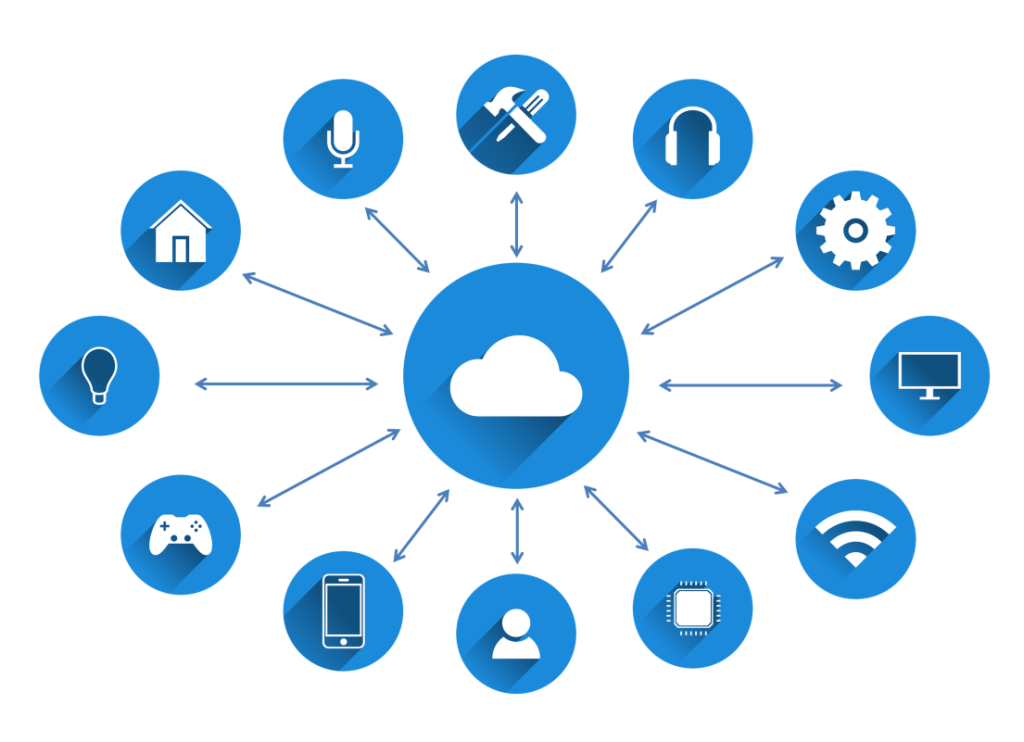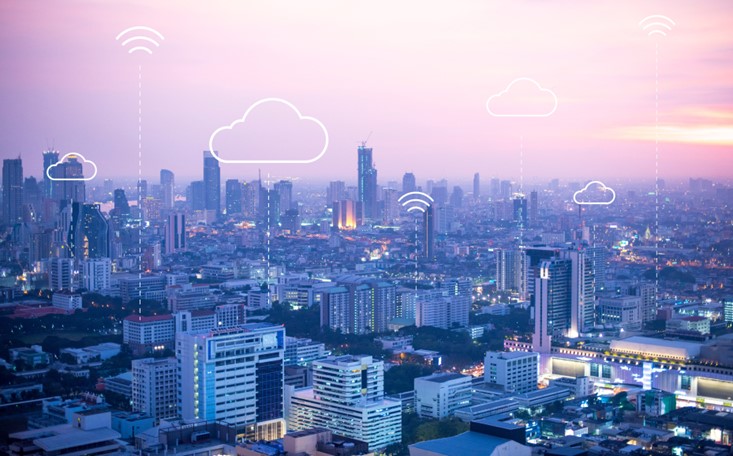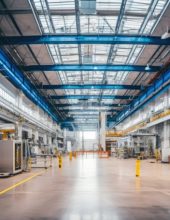The Internet of Things (IoT) is a term referring to a set of electronic devices connected to each other on the broad Internet, exchanging information to improve human life without human intervention. This term was first used in 1999 by the British entrepreneur Kevin Ashton.
In the article, I will provide you with basic information on why it is worth getting to know this subject better.

What do we use IoT for?
IoT has many use cases. One of them is smart homes that can automatically turn on the air conditioning when the temperature rises over a set value, activate a robotic vacuum cleaner, or operate sprinklers at the appropriate time of day. With the help of appropriate sensors, they can inform us about intruders when we are away from home. IoT devices can perform diagnostics, detect faults, and prevent them beforehand, so we may not even be aware that such a situation occurred.
IoT devices and futuristic cities
Examples of devices that form the Internet of Things:
- air conditioners, heating systems, and thermostats,
- modern household appliances,
- smoke detectors, motion sensors,
- automated window blinds,
- surveillance cameras,
- smartwatches,
- plant irrigation systems.
With the development of telecommunication networks and the creation of 5G standard, it became possible to increase the number of devices from a hundred thousand per square kilometer to even a million per square kilometer. This allows for the development of not only smart homes but entire smart cities. Examples of such places are Dubai and Oslo. They also utilize various communication methods among themselves or with servers.
The most popular are:
- Bluetooth,
- NFC,
- Wi-Fi,
- Z-Wave,
- Zigbee,
- Cat-0/Cat-1,
- LoRaWAN,
- Sigfox.
During the development of technology, a particular subcategory emerged – the Industrial Internet of Things (IIoT). It focuses on devices related to the broader known industry. Teams of devices, cameras, and sensors help optimize production, leading to cost reduction and increased efficiency.
Application of IoT in various industries
IoT can also be used in other industries, including:
- Agriculture – environmental sensors are used to obtain real-time information about weather and climate conditions. For example, access to data on soil moisture and condition can help farmers make better decisions regarding the amount of fertilizer and water used, reducing the environmental impact.
- Medicine – devices can monitor patients with illnesses and inform both the patient and the doctor about potential issues, allowing for quick responses. They also assist in patient care by monitoring real-time reactions to administered medications.
- Logistics – devices provide information about road conditions and monitor drivers’ behavior in real-time, preventing potential delays or other issues. This technology helps optimize limited warehouse space. At the same time, IoT can support effective supply chain management by tracking and authenticating products.
- Public sector – concerning the aforementioned smart cities. Devices can facilitate road and traffic management to ensure smoother vehicle flow. A network of intelligent cameras can contribute to improving residents’ safety and help optimize public spaces.
- Retail – the use of devices such as cameras, shelf sensors, and artificial intelligence improves the shopping experience and helps track current product demand to optimize the ordering process.
- Energy and public utilities – devices can monitor the state of sources to optimize energy transmission and prevent possible malfunctions. IoT can monitor water conditions and react to changes in salinity, turbidity, or temperature.
Benefits arising from the evolution of the Internet of Things
The use of IoT comes with many benefits, which include:
- Automation and efficiency – IoT enables the automation of various processes, leading to increased efficiency in both industries and daily life. Automatic devices and systems can perform tasks faster, more accurately, and without human intervention, saving time and resources.
- Personalization of services –thanks to IoT, companies can offer more personalized services and products tailored to individual preferences and needs, increasing customer satisfaction and improving user experiences.
- Optimized urban infrastructure – IoT allows for smart city management, leading to better infrastructure and more efficient resource utilization. Examples include smart street lighting, traffic management, and waste management.
- Remote monitoring – IoT enables remote monitoring of various devices and processes, such as remote health monitoring of patients, machine monitoring in industries, or environmental quality monitoring.
- Energy savings – IoT enables better energy consumption management. Smart systems allow for adjusting energy usage according to current needs, leading to savings and a more eco-friendly approach.
- Security and protection – IoT can improve security at multiple levels. In industries, it can assist in monitoring worker safety, and in daily life, it allows access to alarm systems and surveillance cameras.
- Business development – IoT opens up new business opportunities. This can involve introducing new products and services, as well as creating intelligent solutions tailored to customer needs.
- Diagnostics and data analysis – IoT generates vast amounts of data that can be utilized for analysis and problem diagnosis, enabling more informed business decisions and therapeutic approaches in medicine.
- Access to real-time information – IoT allows for access to real-time information, facilitating faster responses to changes and quicker decision-making.
- Comfort and convenience – In daily life, IoT can increase comfort and convenience. Home automation, remote device control, and smart assistants are just a few examples.
Risks of using IoT
As with everything, using Internet of Things devices comes with certain risks. Smart homes can collect very detailed information about us, such as our sleeping and working hours or the type of car we have in the garage. Cybercriminals may attempt to access such information; however, manufacturers of smart devices continually work to ensure maximum privacy and security for their customers. The most popular method is data encryption transmitted between devices.
Summary
The Internet of Things is one of the most promising and exciting technologies of the modern world. Its impact on our lives is already evident, and technological development continues to provide immense possibilities for further expansion. IoT applications cover diverse fields, from smart cities to environmental protection and healthcare. However, along with its benefits, challenges related to security, standards, and data protection also arise.
The future of IoT seems promising, especially with the growing significance of 5G technology and integration with artificial intelligence. Undoubtedly, the Internet of Things will continue to play a crucial role in transforming our society and economy in the coming years.
***
For more on IoT, see other articles by our experts.
















Leave a comment